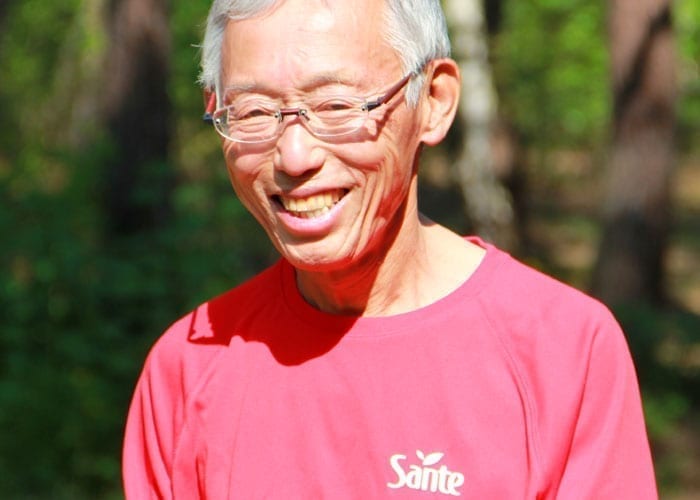
Slow jogging has captured the hearts of physical activity fans around the world. This running training technique, which originated in Japan and is extremely simple, has been recognised as an effective form of preventive health care. It helps prevent lifestyle diseases, eliminates the effects of a sedentary lifestyle and contributes to improving the functioning of the entire body. During a workout, you don’t sweat, you don’t get tired and you can even talk or sing songs freely. What more could you want?
Slow jogging – what is it?
Slow jogging belongs to running training methods and consists of slow running (initially even slower than trotting) in which small steps are taken (cadence: approximately 180 steps per minute).
During slow jogging training, the feet land on the midfoot, thus making use of their natural cushioning mechanism – the foot arch. This safe landing protects us from injuries and trauma to the knee, ankle and hip joints.
Slow jogging is first and foremost a pleasure. We run at our own pace, we don’t strain our bodies, we don’t get sore, and the endorphins do their job anyway. Just 30 minutes of training a day (at least 6 times a week) is enough to feel the tangible effects. Of course, slow jogging even in smaller doses will be beneficial to our health and well-being.
Who invented slow jogging?
Slow jogging (English for slow running) was born out of years of research into the physiology of exercise and endurance training. It was conducted by Hiroaki Tanaka, a Japanese professor of health sciences at the Institute of Sports Physiology at Fukuoka University. He was looking for an easy and effective sporting activity that could be practised by almost anyone and that would benefit health without putting a strain on the body.
At first, the Japanese were sceptical about the idea of slow jogging, but when it was recognised by the American Society of Sports Medicine as an extremely effective way of combating lifestyle diseases, it became extremely popular.
Niko niko – run with a smile
One of the main tenets of slow jogging is to train at your own pace, which Prof Tanaka refers to as niko niko, which in Japanese means with a smile. The idea, therefore, is to make the workout light and relaxed enough for us to smile as we run.
Over time, the pace ranges in slow jogging have been refined. People who are in excellent condition and who play sports on a daily basis can reach speeds of up to 12 km/h in slow jogging. Intermediate joggers will find their niko niko in the 7-8 km/h range. On the other hand, those who are just beginning their adventure with physical activity can easily jog at a speed of 4-5 km/h.

Benefits of slow jogging – how does it work on the body and mind?
Slow jogging is one of the safest physical activities for the body. Here are some of the benefits it brings:
- strengthens the body’s natural immunity,
- counteracts diseases of civilisation, such as diabetes, obesity, hypertension, atherosclerosis or heart disease,
- improves physical and mental condition (influences the formation of new brain cells),
- delays the effects of ageing and counteracts senile dementia and Alzheimer’s disease,
- helps to lose weight (we burn 2x more calories than when walking).
There are also several reasons why slow jogging is often chosen over traditional running training:
- it requires no preparation,
- it is not tiring,
- it is simple and enjoyable,
- almost anyone can do it,
- does not cause soreness,
- injury-free
- does not require recovery breaks,
Which shoes for slow jogging?
Shoes for slow jogging should primarily be flat (so-called zero drop), breathable and comfortable. There is no need to buy special cushioned running shoes, because in slow jogging, as we have already mentioned, you land on your midfoot, so it has more in common with natural (minimalist) running than with traditional running technique. It is important that slow jogging shoes have a thin sole – it will be much easier to feel the landing point. Also check the flexibility of the sole, as slow jogging shoes should support the
the natural movement of the ankle and joint apparatus of the foot. Minimalist shoes, such as the Explorer model, are ideal here.
Slow jogging – how do you get started?
The most important feature of the slow jogging method is its simplicity. We do not need any special skills or predispositions. Slow jogging is actually for everyone – regardless of age or health status. And here is what Prof Tanaka himself advises beginners:
“(…) with slow jogging we do not need any special technique. Let’s open our mouths slightly and rely on nature. Let’s try to jog for 30-60 minutes a day. For those who find it difficult to carve out the time, I recommend starting with ten minutes, three times a day.”
Let’s remember to run at a niko niko pace, which is our own – one that allows for casual conversation and a simple, natural smile.
Finally, we encourage you to watch a short video featuring the creator of slow jogging himself.

Leave a Reply